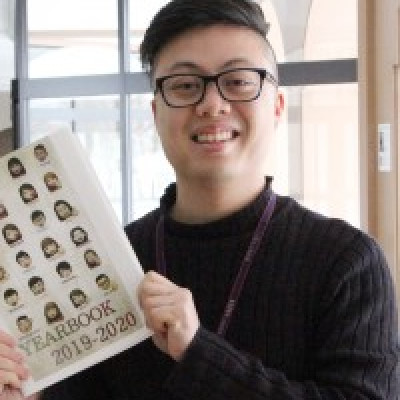Sessions / Location Name: Room H
Virtual Location
Virtual: You cannot enter virtually via this page. Click on the titles of individual presentations or go to the Live Page
The impact of COVID-19 on self-access support: The precarious transition to online language learning advising #1495
Since the outbreak of Covid-19 in early 2020, Japanese higher education has had to come to terms with finding optimal online solutions for providing and continuing the education of university students. One of the facilities naturally caught up in this has been self-access learning centres (SALCs). With language learning advising being a key service such centres offer, it has been requisite for those working in them to make the transition from face-to-face to some kind of online distance support for students. Moreover, as non-teaching staff are said to be most vulnerable to position reductions given possible financial cuts arising from tuition fee cancellations or student enrolment reductions, there has been increased pressure to justify what they do as critical to the continuity of learning (UNESCO, 2020). These circumstances have indeed had a direct impact on how such self-access staff advise learners and inevitably changed the nature of their work. Consequently, this presentation reports on a qualitative exploratory study undertaken with one self-access manager at a Japanese university who was purposively selected to examine this issue. Semi-structured interviews and subsequent thematic analysis showed that making the transition to online language learning advising has been challenging for this individual with continuous pressure to demonstrate innovation and the necessity of his position.
A systematic review of 50 years of automated question generation research #1432
Questions play a fundamental role in education. Although constructing questions has been, and is generally conceived of as, a manual process, Automated Question Generation (AQG) is a burgeoning area of Intelligent CALL (Underwood, 1989) formed from a synergy of research strengths from Artificial Intelligence and Natural Language Processing. Over the past 25 years of CALL research, AQG has been used to supplement educational activities (e.g., answering practice questions) in large-scale courses (e.g., MOOCs) and advance computer assisted language testing (e.g., adaptive testing).
This presentation will first offer an overview of the AQG research across language learning and assessment studies that covers six key dimensions: 1) knowledge source for question generation (e.g., ontology, text), 2) generation method (e.g., template, syntax), 3) question type (e.g., WH-factual, cloze), 4) response format (e.g., open-ended, multichoice), reliability check (e.g., correlation with external exam scores) and 6) evaluation (e.g., expert, student). The primary aims of the presentation are to provide an overview of the AQG research as related to language learning and to discuss with the audience the benefits and drawbacks of using automated generated questions for classroom activities and assessments.
Transitions and connections: student reflections on emergency remote teaching and learning (ERTL) in 2020 #1396
The Covid-19 pandemic of 2020 transformed the educational spaces and lives of teachers and students worldwide. According to UNESCO (2020), over one and a half billion students around the world were learning remotely in March 2020 due to pandemic concerns. First-year university students in Japan were particularly affected by this, moving from high school to university during this period, and therefore facing multiple challenges. This presentation explores the results of an investigation using videos made by students to record this pivotal time. The participants were asked to create three-minute videos in which they reflected on their experiences of ERTL. The videos were uploaded to the university LMS and permission received for use. They were then analyzed, revealing a continuum of participation, engagement and success. The students were found to own the necessary technology to engage in online learning, negating concerns about a possible digital divide. Significant gaps were revealed, however, in the frequency of use and experience of technology, especially in academic contexts. This led to technostress which was compounded by a lack of technical support. Additionally, strong feelings of disconnection, isolation and lack of community were expressed. Positive aspects of ERTL reported include increased flexibility in terms of time, place, and pace of learning, which contribute to more inclusive learning spaces and increased student control of their learning environments. The students’ insights provide vital information about what is needed to participate and succeed in online educational environments, and implications for education moving forward will be discussed.
UNESCO (2020) https://en.unesco.org/news/unesco-rallies-international-organizations-civil-society-and-private-sector-partners-broad
The uptake and impact of Clilstore, a Content and Language Integrated Learning dedicated authoring tool and repository #1436
This presentation explores the uptake, impact and use of the Clilstore authoring tool and open access repository of ready-made educational resources for content and language integrated learning. The system has been undergoing constant development since its inception during the “TOOLS for CLIL Teachers” project and is currently undergoing extensive improvements by virtue of the “CLIL Open Online Learning” project. Both projects were co-funded by the European Commission. The analysis is based on the data obtained from a survey administered to registered users. A cross-section of educational practitioners who had registered with Clilstore was invited to provide feedback on a range of factors relating to the platform's functionality and the impact it had made to their professional practice. There were 61 responses with a sectoral breakdown of Secondary = 36%; HE = 28%; FE = 27%; Other (Primary, Community) = 9%. The authors will discuss the findings according to five broad categories: uptake, exploitation, uniqueness, innovation, and awareness. To conclude they will illustrate the system and highlight its potential benefits for both autonomous and guided learning.
Empowered learning using video essays in a film studies course #1453
This paper focuses on the use of CALL in a Film Studies course focusing on women in Media. This course, taught in the spring semester 2020, used a variety of online media and software to build a student centred learning experience. A literature review will present pedagogical rationale for this study: Abdulrahman, 2018; Broadaway, 2012; Harb, 2018; Hernández, Cuevas, & Valencia, 2018 demonstrate the benefits of using authentic, non-traditional language-learning media in an EAP context. In this study, thirteen EFL students taking a course on foreign films at a women’s university in Japan were taught aspects of feminist film theory such as the Bechdel Test, Male Gaze and the Dumb Blonde via engaging YouTube video essays. Students were given full control over the video material to individually play and replay to improve comprehension. Then they collaboratively answered quiz questions in small groups. Students participated in online discussions and lengthy presentations via Zoom and FlipGrid. The authors used online surveys to ascertain students’ impressions of the feminist materials studied and how they perceived the usefulness of the language skill-building activities employed. This paper will discuss the results of the study and provide recommendations for using online media and LMS to assist EAP instruction.
A tale of ‘too’ many LMS’s #1438
The past year has shown us both challenges and opportunities in education in particular socialization, collaboration and interaction for research, discussion, support, and exchange of ideas. Social distance and the inability to connect physically has created barriers to the type of communication required for learning, teaching, and researching. To help bridge this divide, institutions hastily struggled to implement a range of Learning Managements Systems LMS’s to address both teachers and students needs. The result was a collage of contradictory, conflicting and complementary platforms that greatly assisted and facilitated some endeavors but hopelessly added to the burden and confusion of others. Far from there being any logical consensus, teachers had to experiment and trial systems in this ‘wild west’ of online classrooms, finding out what worked and what didn’t, and in many cases relearning how to teach. Students were equally plagued by this inconsistency and in some cases had a different platform for each class. What did we learn from this? Will the experience of LMS based teaching have a lasting impact on education? The following will describe an “Integrated English” Program for freshmen and sophomore English majors and how it was coordinated, managed and adapted to online learning.
Presenters will discuss the results of two surveys conducted to evaluate the online learning and teaching experience. The research surveyed 280 college students and 39 instructors regarding their worries, fears, challenges and triumphs using various LMS’s ranging from Webex and Zoom to Course Power and Google Classroom.
Digitally-enhanced practices in foreign language teacher education: fostering active learning and student engagement in online learning environments #1404
Since spring 2020, Higher Education Institutions have engaged in extensive online teaching worldwide. In this respect, emergency remote teaching has had a deep impact on the development of post-Covid teaching practices at tertiary level. In this light, while devising digitally-enhanced pedagogical practices suited to the new normal, instructors need to take into account some newly emerged dimensions, such as flexibility, a pedagogy of care, and collaborative learning (Bozkurt et al. 2020). As a result, in post-pandemic educational contexts, digitally-enhanced pedagogical practices need to be reframed to provide students with flexible learning implemented from a pedagogy of care perspective (Jackson 2021). Online courses thus need to be redesigned to foster student engagement, student agency, collaborative learning, and critical thinking. In this perspective, this presentation aims to illustrate how transformative learning practices have been successfully implemented, from a pedagogy of care perspective, in an online foreign language teacher education course offered at an Italian university in the present academic year. To this purpose, the analysis of learners’ perceptions collected in the course, showing a high degree of student engagement, student agency, collaborative learning, and critical thinking, will be examined. In the course, implemented within a socio-constructivist theoretical framework (Selwyn 2016), learners have engaged in various digitally-enhanced activities devised in keeping with a design for learning approach, fostering students’ active learning and agency (Goodyear 2015; Rapanta et al. 2020). This presentation may be especially useful to instructors planning to develop highly engaging digitally-enhanced foreign language teacher development in post-pandemic educational contexts.
Do Kahoot games enhance vocabulary learning? #1478
Nowadays, many educators are considering using online games for learning vocabulary. Among the existing online games, one of them is Kahoot. The purpose of this study is to find out if male students and female students learn vocabulary the same way by using Kahoot games. The study looked at whether there is any significant difference among the female and the male groups in their vocabulary enhancement? This was a quantitative research study with a comparative design using pre-test and post-test. This research was carried out on a sample size of 68 7th-grade students. There were 33 female and 35 male students. Vocabulary tests were administered to both groups by utilizing a pre-test and post-test. The content of the lessons learned for female and male students was the same. The findings revealed that there was a significant difference in vocabulary enhancement between female and male students using Kahoot games (based on the t-test analysis): the mean difference from both groups is 0.006 < 0.05 which mean there is a significant difference in students’ vocabulary enhancement. The normalized gain score results showed significant enhancement in female and male groups. Both groups revealed that there is an increase in the students’ vocabulary scores. Furthermore, this research showed that there were positive responses concerning the method applied in the enhancement of students’ vocabulary, based on the questionnaires administered to the participants at the end of the program. Therefore, it can be concluded that Kahoot games are an effective method for teaching vocabulary. Further information that proved that Kahoot games enhanced students’ vocabulary will be discussed in the presentation.
Utilizing Flipgrid for Speaking Activities #1634
In 2020, the COVID-19 pandemic forced many educational institutions to implement ERT, which resulted in courses going online across Japan. Many teachers were faced with creating asynchronous or on-demand materials to meet the educational goals of their classes. The purpose of this study was to investigate the use of Flipgrid as a face-to-face speaking activity replacement. The study used four criteria based on asynchronous teaching as well as feedback from student surveys to determine Flipgrid’s efficacy as a face-to-face replacement and the use it may serve for future online or hybrid English courses. The use of Flipgrid had some observable positive and negative impacts. Students stated that motivation to learn English, as well as their listening and speaking ability grew over the first semester of the course. However, some student participants remarked that they were apprehensive to show their faces on camera for teachers and peers to see. The lack of real-time feedback from teachers and peers may also be an obstacle to overcome for Flipgrid to be an effective replacement for face-to-face speaking activities.
TeacherTools: An introduction and implementation in a Japanese university EFL context #1416
Last year saw a sudden increase of online teaching software, platforms, and applications come to the forefront of education around the world due to the effects COVID-19 and the transition to online teaching. This presentation explores the implementation of one such tool, TeacherTools.digital, an online activity creation tool for educators. TeacherTools allows users to create various online activities that focus on the main four skills, including audio and video recordings, gap fills, speech recognition, and writing. These activities can be easily accessed by students and comes complete with an incorporated gradebook system. It was selected mainly for the ease of material creation, automated grading, and especially the lack of login requirements for students. With educators possibly using multiple online platforms that require students to log in, this ease of access proved a critical feature. The main focus of this presentation is to introduce and example some of the main features, detailing how the platform was implemented in the presenter’s courses and in other contexts. Finally, the presenter will discuss the advantages and disadvantages of the platform in addition to feedback from other users at the institution.
Using Alexa for autonomous foreign language learning #1476
This presentation details two case studies that examined the use of intelligent personal assistants (IPAs) for autonomous L2 learning: one involving L2 English learners (N=14) and another involving L2 Japanese learners (N=6). The studies utilized similar research designs, L2 students of both languages used the target IPA, Alexa, in their homes over a two-month period. The goals of the studies were as follows: assess students’ views of Alexa for autonomous L2 learning, understand their L2 usage habits concerning the IPA, learn what strategies they used to resolve English communication breakdowns with the IPA, and explore the reliability of Alexa to comprehend the students’ L2 Japanese speech. Students’ views of Alexa for autonomous L2 learning were assessed through a technology acceptance model (TAM)-based survey which examined three TAM constructs (usefulness, effectiveness, and satisfaction) as well as open-ended written response questions. The reliability of Alexa to understand L2 Japanese was evaluated by comparing the automated transcriptions produced by the IPA with human-rater transcription of the participants’ audio-recorded utterances. While analysis of the L2 Japanese case study results is ongoing, findings from the study on autonomous L2 English learning with Alexa indicated that participants had mostly favorable views of the IPA for autonomous language learning. Nevertheless, the results showed that the students tended to give when facing communication difficulties and that the learners did not actively use Alexa in their homes. Additional findings and implications from the case studies will be discussed in the presentation.
Don't forget about Webinars!: Different scenarios to utilize professional meetings in Zoom #1402
This past year has seen a complete change in the way we use technology. Zoom has more than impacted our online capabilities and skillsets: it has added additional tools in our toolbox to further enhance our classrooms. While Zoom Meetings has primarily taken center stage, the Zoom Webinar function should not be overlooked. Through understanding its potential, Zoom Webinars can vastly outshine regular Zoom Meetings. This workshop will look at the different scenarios in which Webinars can be used more efficiently and effectively. The workshop will also explain how to perform basic Zoom Webinar admin functions, including sharing the Webinar licenses with a team. It is hoped that participants (whether new or experienced) will leave the workshop with many new tech and teaching skills utilizing Zoom Webinars as we (hopefully) transition back into F2F.















